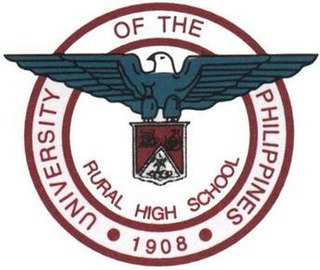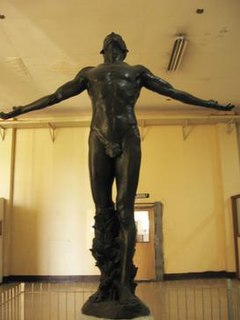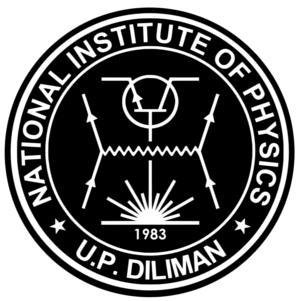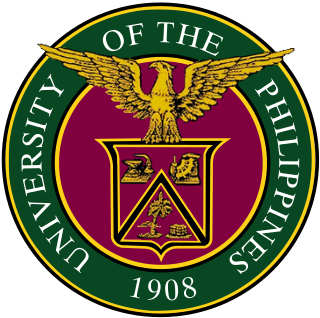
The University of the Philippines Rural High School was established as a subsidiary of the Department of Agricultural Education of the University of the Philippines College of Agriculture, pursuant to Sec.4 of Act 3377 of the Philippine Legislature which was approved on December 3, 1927. The school, with a vocational curriculum, served as a practice school for the training of teachers, provided secondary education in agriculture for those preparing for college, and trained intermediate school graduates in agriculture.

The Oblation is a concrete statue by Filipino artist Guillermo E. Tolentino which serves as the iconic symbol of the University of the Philippines. It depicts a man facing upward with arms outstretched, symbolizing selfless offering of oneself to his union.

Quezon Avenue Station is a station on the Manila Metro Rail Transit System Line 3. Quezon Avenue station is one of the many elevated stations that can be found on the line. The station is located in Diliman in Quezon City and is named after Quezon Avenue, one of the busy thoroughfares of Quezon City.

The School of Library and Information Studies of the University of the Philippines or UP-SLIS is the oldest library school in the Philippines. Formally established in March 1961 as the Institute of Library Science, it can trace it roots to 1914, making it one of the first library schools in Asia. It is an independent degree-granting unit of the University of the Philippines Diliman, and offers programs in the field of library and information science. In December 2015, the Commission on Higher Education declared the school as the first Center of Excellence among the universities and colleges with library and information programs in the Philippines.

The University of the Philippines Visayas is a public research university in the Philippines. A constituent university of the University of the Philippines system, it teaches management, accountancy, marketing, economics, chemistry, applied mathematics and physics, marine science education and research, fisheries, and aquaculture. It offers regional studies programs on the preservation and enrichment of the Visayan cultural heritage.

The Jorge B. Vargas Museum & Filipiniana Research Center, located at the University of the Philippines Diliman campus, houses the collection of art, stamps and coins, library, personal papers and memorabilia of Jorge B. Vargas which he bequeathed to the university. It is under the management of the UP Diliman College of Arts and Letters.

Commonwealth Avenue, formerly known as Don Mariano Marcos Avenue, named after the father of President Ferdinand Marcos, is a 12.4-kilometer (7.7 mi) highway located in Quezon City, Philippines, which spans from 6 to 18 lanes and is the widest in the Philippines. It is one of the major roads in Metro Manila and is designated as part of Radial Road 7 (R-7) of the older Manila arterial road system and National Route 170 (N170) of the Philippine highway network.
The College of Arts and Sciences (CAS) is one of the eleven degree-granting units of the University of the Philippines Los Baños. It is the largest college in University of the Philippines System which offers most of the general education subjects required of UPLB students, as well as the highest number of degree programs in the University. The Philippines' Commission on Higher Education has recognized CAS as a Center of Excellence in Biology, Chemistry, Information Technology and Mathematics, as well as a Center of Development in Physics and Statistics.
The College of Economics and Management (CEM) is one of the eleven degree-granting units of the University of the Philippines Los Baños. It is the first in Asia to offer degree programs in Agricultural Economics and has trained agricultural, resource and environmental economists from all over the continent.
The College of Veterinary Medicine (CVM) is one of the 11 degree-granting units of the University of the Philippines at Los Baños. It is the country's first veterinary school.

The U.P.–Ayala Land TechnoHub is an information technology hub jointly developed by the University of the Philippines Diliman and property developer Ayala Land. It is located in Commonwealth Avenue, Barangay U.P. Campus, Quezon City. It occupies 20 hectares within the 37.5 hectares of the U.P. North Science and Technology Park.

Asian Institute of Tourism is one of the colleges under the University of the Philippines System and is located at the UP Diliman campus.

The National Institute of Physics (NIP) was established in 1983 by Presidential Executive Order No. 889 which transformed the Department of Physics of the College of Arts and Sciences into one of the seven research and academic institutes of the University of the Philippines Diliman - College of Science.

North Avenue is a major road located in Quezon City within the Diliman area of northeastern Metro Manila, Philippines. It runs east–west through the northern edge of the barangay of North Triangle. The street is located in Quezon City's mixed-use and government area, known for its malls, condominiums, hotels, and the upcoming QC CBD. It is also home to the SM City North EDSA, Trinoma, and Ayala Malls Vertis North located on the avenue's junction with Epifanio de los Santos Avenue (EDSA). The entire avenue is designated as National Route 173 (N173) of the Philippine highway network.

Timog Avenue is a major road located in Quezon City within the Diliman area of northeastern Metro Manila, Philippines. It runs east–west through the southern edge of the barangay of South Triangle and used to be named in English South Avenue. The street is located in Quezon City's entertainment area, known for its restaurants, bars and karaoke and comedy clubs. It is also home to the GMA Network Center studios located on the avenue's junction with Epifanio de los Santos Avenue (EDSA). The entire avenue is designated as National Route 172 (N172) of the Philippine highway network.

U.P. Town Center abbreviated as UPTC is a shopping center in Quezon City, Metro Manila, Philippines, managed by the Ayala Malls group. It opened on September 30, 2013.
Marian P. Roque is a Filipina mathematician. She is the president of the Mathematical Society of the Philippines, a professor in the Institute of Mathematics of the University of the Philippines Diliman, and head of the Institute of Mathematics. Her mathematical specialty is the theory of partial differential equations.






















